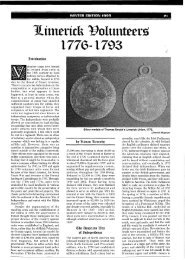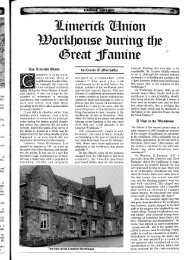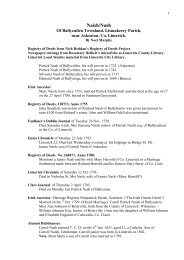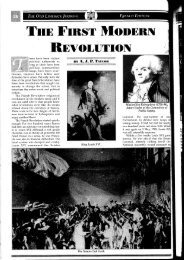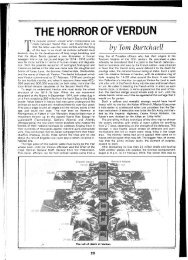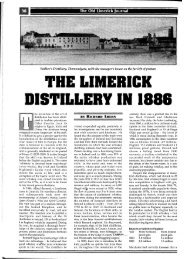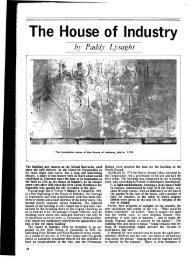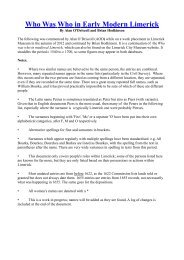pages 555 to 683 (4602 Kb) - Limerick City Council
pages 555 to 683 (4602 Kb) - Limerick City Council
pages 555 to 683 (4602 Kb) - Limerick City Council
You also want an ePaper? Increase the reach of your titles
YUMPU automatically turns print PDFs into web optimized ePapers that Google loves.
632 C<br />
.<br />
BISTORY OF LIMEBICK.<br />
Dwed Limerc'cmb, <strong>to</strong> which he affixed a brief memoir of the life of the<br />
Right Rev. Dr. O'Keeffe, who, as we have seen, was the first <strong>to</strong> enact<br />
these statutes on the revival of religion after the violation of the treaty of<br />
<strong>Limerick</strong>. In the government of the diocese, Dr. Young was strict and<br />
particular, whilst in his demeanour <strong>to</strong> all classes, he was kindly, cheerful,<br />
and affable. He won the affections by a charming manner, and preserved<br />
that dignity which became the scholar and the prelate, without effort<br />
or sffectation. Devoted <strong>to</strong> books, he read copiously and profitably; his<br />
reading embraced every variety of subject connected with theology, the<br />
Scriptures, canon law, the classics, his<strong>to</strong>ry, ancient and modern, antiquities,<br />
eta; and his annotations on the booka in his own as well as in the<br />
diocesan libr , are, in some instances, extant, and show the extent and<br />
versatility of 9 is information on almost every sub'ect connected with<br />
aacred and profane literature. He, as well as the o a er bishops of Munster,<br />
condemned in no measured terms the Rebellion of '98, which the<br />
Irish e isco acy and clergy in general resisted with aU their dombined<br />
strengt Ran ' B power. We do not find that he issued a pas<strong>to</strong>ral add=<br />
<strong>to</strong> his flock on the subject, at least we have no record of such as was<br />
addressed by Dr. Moylan, of Cork, Dr. Hussey, of and Dr.<br />
Michael Peter MacMahon, of Killal~e,~, who, at the time continued <strong>to</strong><br />
reside in <strong>Limerick</strong>. In all likelihood, Dr. Young did address a pas<strong>to</strong>ral:<br />
and that he exerted himself with zeal, skill, vigour, and success, in warning<br />
his flock of the danger they incurred, there is no doubt whatever. As we<br />
have already seen, he was one of the first in <strong>Limerick</strong> <strong>to</strong> insert his name ss<br />
a subscriber <strong>to</strong> the &U e fund that was raised for the defence of the county<br />
from the threatened 9 renoh invdon. Whilst he was loyal <strong>to</strong> the throne,<br />
however, he thought that <strong>to</strong> afford the government a control over the privileges<br />
of the hierarchy in the nomination of bishops, or in any other &a<br />
or form, was <strong>to</strong> be .esisted by all honourable means and a pliances. g<br />
opposed the insidious advances of Mr. Pitt and Lord Cas S ereagh as weU<br />
for %he sub-ugation of the Catholic Church ss for the destruction of hi&<br />
freedom. !In January, 1799, a meetin of certain Irish relates W@ held<br />
in Dublin, at which resolutions were a % opted in favour o P a state provision<br />
for the olergy, and of a ve<strong>to</strong> on the appointmat of<br />
the bishop. The name Young does not a p ~<br />
among the names of the resolved on that itcaslon;<br />
but we find bim in 1808, the Irish hierarchy held in<br />
Dublin in the month of September that ear, denouncing the roposed<br />
change, and statin~ in language not <strong>to</strong> L mistaken or misun B ers<strong>to</strong>od,<br />
that it was inexpedient <strong>to</strong> introduce an alteration in the canonical mode<br />
hither<strong>to</strong> observed in the nomination o F Irish Catholic Bishops. On the<br />
24th of February, in the year 1810, another meeting of the Irish hierarchy<br />
was held in Dublin, and resolutions <strong>to</strong> the same effect were adopted The<br />
resolutions of 1808 were not only then confirmed, but their lordships resolved<br />
that they neither sought nor desired any other earth1 consideration<br />
for their spiritual minis <strong>to</strong> their flocks, save what the floc T s from a sense<br />
of religioa and duty mig t voluntarily aord them. We find his name sub<br />
7?<br />
1 The episcopal real of the Right Rev. Dr. IthNahn b in the poaseasion of the Right Rev.<br />
Dr. Power, Wju<strong>to</strong>r bishop of -0% who RI oonse~llted. by the Moat Rev. Dr. LesBy,<br />
Lord Archb'ishop of G-hd Em& attended by 9 tho b&op of Mu~ter, ip Nenagh<br />
Catholio ohpro4 OQ SW*, JUW %th, 1866.<br />
HISTORY OF LIMERICK. 633<br />
scribed also <strong>to</strong> an address of the prelates which was issued in the same<br />
month <strong>to</strong> the clergy and laity of Ireland, reiterating their former resolutions,<br />
and further declaring, that during the captivity of the Pope, who<br />
then lay a prisoner in the hands of Napoleon Buonaparte, they would<br />
refuse and reprobate all briefs or pretended briefs, rules and rescripts,<br />
bearing title as from his Holiness, and purporting <strong>to</strong> be declara<strong>to</strong>ry of his<br />
free", or of any abdication of the papal office, until His Holiness should<br />
enjoy the full exercise of his liberty.<br />
As a friend of education, and one of a family that had afforded so many<br />
brilliant members <strong>to</strong> the Church, Dr. Young, about the year 1805, conceived<br />
the design of erecting a college in which students destined for the sacrcd<br />
ministry shouldbe educated.' There had been, at Peter's Cell, a small col-<br />
Iege some time before, but it was <strong>to</strong>o contracted for the increasing requirements<br />
of the diocese, and Park College, near Park House, the bishop's residence,<br />
was at length erected, <strong>to</strong> the building of which the Catholic citizens of<br />
<strong>Limerick</strong> contributed cheerfully and liberally. The Grst president of Park<br />
College was Dr. Young, and his lordship was succeeded in tlie presidency by<br />
the Very Rev. Dean Hanrahan, a learned and accomplished dignitary. The<br />
Right Rev. Dr. Milner, the vicar-apos<strong>to</strong>lic of the midlaxd district of England,<br />
in the course of his <strong>to</strong>ur through Ireland, visited <strong>Limerick</strong> in ISOS,<br />
and was hospitably received by Dr. Young, who, <strong>to</strong> gratify the antiquarian<br />
zeal of the learned and gifted his<strong>to</strong>rian of Winchester Cathedral, and the<br />
indefatigable and chivalrous defender of the faith in various important publications,<br />
obtained a clever artista <strong>to</strong> make a drawing of the mitre and crozier<br />
of Cornelius O'Dca, which Dr. Young presented <strong>to</strong> Dr. Milner, and which<br />
Dr. Milner got engraved afterwards for the Archzeological Society of London,<br />
with a letter-press description, as already stated. It is impossible <strong>to</strong><br />
estimate the &mount of good which the apos<strong>to</strong>lic Dr. Young performed in<br />
his time. His name <strong>to</strong> this day is held in veneration by the people.<br />
He was particularly fond also of encouraging local genius, especially<br />
painters, and <strong>to</strong> that encouragement may be attributed the number of excellent<br />
paintings which adorned the Catholic churches of <strong>Limerick</strong>, and<br />
some of' which are yet in exi~tence.~ Succumbing at length <strong>to</strong> illness,<br />
' The efforts made by the Irish hierarchy and priesthood were constant and snccessful for<br />
education in ancient, as well as in more modem times.<br />
Two colleges were erected for the native Irish, before Trinity College, Dublin, and founded at<br />
Salamanca in 1682.<br />
At the instance of Thomas White, native of Clonmel, one of these<br />
At Alaaln in 1590, by do.<br />
At Lisbon and Genoa, in 1595, by do.<br />
At Douai, in 1596.<br />
At Antwerp, in 1600.<br />
At Tournay, 1607.<br />
At Lille, 1610.<br />
At LOUT 1616.<br />
*-*- $' -$<br />
At Rome 625, by Luke Wadding.<br />
'.*L - d. --'q..7!>: ,<br />
B Mr. John Gnbbins. U /<br />
In Dr. Young's time, viz., in 1808, ~ r 0nen . ~adden, arespeotableparislr~mergf ~h&ona~* '<br />
gate, presented Thomondgate chapel with a painting of the Ascension, by Henry Single<strong>to</strong>n,<br />
A.R.A. for which Mr. Mdden nave fiftv mineas. It was a beautiful picture. but it has been<br />
greatliinjured by injudicious aeaning I &d about tlie same time Fredirick ~ k iPlowman, a<br />
a clever portrait painter, and student of the R. A. in Sir Joshua Reynolds' time, visited<br />
<strong>Limerick</strong>, and painted, among other subjects, the Virgin and Child, surrounded by Angels, for<br />
Father DenL Hogan, O.S.F., and a Crucifixion for him also. These pictures are in the Franciaaan<br />
chuwh, Henry Street. Plowman painted a first-ola~a portrait of Father Denis Hogan<br />
44



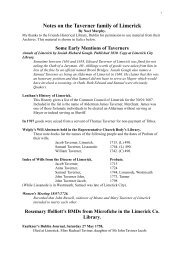
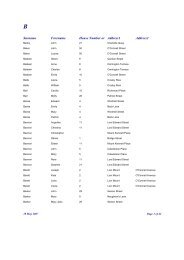
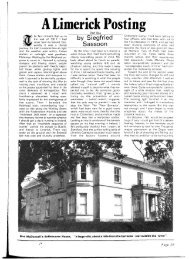
![The Galbally farmer [poem] by Darby Ryan - Limerick City Council](https://img.yumpu.com/24792577/1/190x260/the-galbally-farmer-poem-by-darby-ryan-limerick-city-council.jpg?quality=85)
